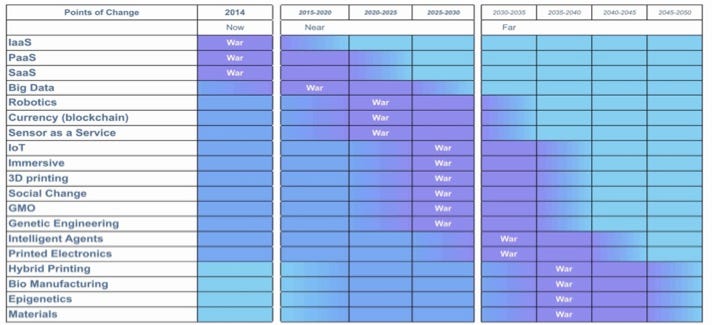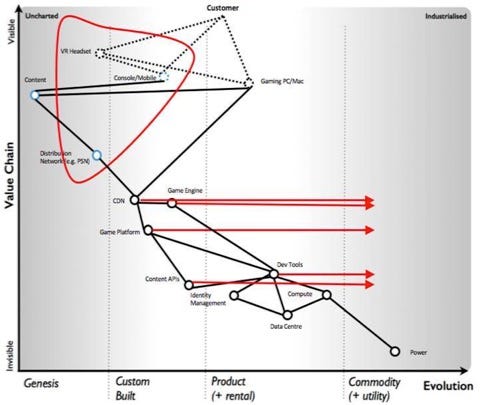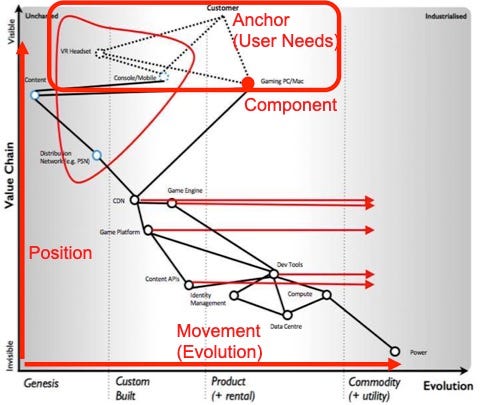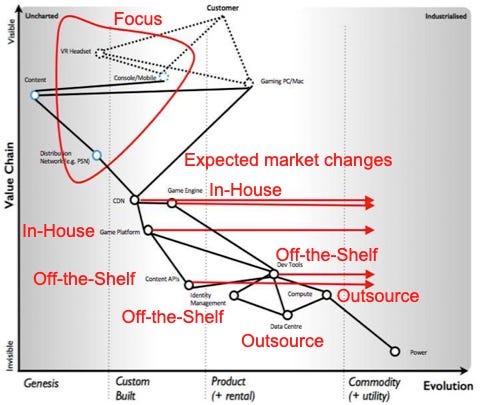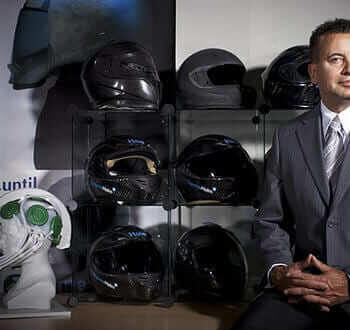“The future’s so bright I gotta wear shades.” Pat MacDonald
How do we visualize the present to create the future? One way to predict the future is to create it collaboratively guided by Supertrends and Wardley Maps. By mapping the technology and business landscape, we can start anticipating the future by looking at patterns of technology and business evolution, and then, start making informed choices on what to do.
Seeing Around Corners
How do you see around corners?
Like this? Using a smart tool?
Or like this?
Using a smart human solution?
Or, using a combination of smart tools and smart humans?
Professor Rita Gunther McGrath of Columbia Business School has been researching innovation and strategy, since the 90s.
This is her advice for starting to see around corners:
- Forget the past, embrace the future.
- Stay true to your core competencies.
- Bring in diverse perspectives.
Let’s see keep this in mind during our forthcoming explorations.
How To Spot Technology Trends
“The future is already here— it’s just not evenly distributed.” William Gibson
One way is to spot technology trends is to check the predictions by strategists and futurists such as Simon Wardley (swardley) and Lars Tvede.
Wardley’s Trends
Strategist Simon Wardley (swardley) spotted the following trends in 2014:
Times of war in the table above indicate that the trends are becoming more industrialized, typically by industrializing existing products into commodity components and/or utility services. This is when new business models and organizational forms appear, and market disruptions are greatest.
These were the key insights from this trendspotting exercise:
- The industrialization and standardization of the Internet of Things (IoT).
- The emergence of Sensors-as-a-Service (not to be confused with Software-as-a-Service) as a platform for Big Data.
- The integration of physical and electronic 3D printing into hybrid printing.
- Cross-industry forms of software agents and artificial intelligence.
Tvede’s Supertrends
Futurist Lars Tvede spotted these Supertrends in 2019:
Scientific activity doubling every 15 years – as measured by the number of academic research articles published in refereed journals – which leads to exponential innovation in both academia and society at large.
Digitalization: we see exponential growth when technologies move from analog to digital, e.g.
- sequencing and synthesising of DNA,
- global growth in the number of Internet of Things/connected devices,
- the amount of digital data produced and stored,
- the amount of bandwidth and transmission speed available for data transfer,
- the global OLED screen area output,
- the number of usable radio frequencies,
- the performance of LEDs, batteries, hard drives, …
Programming biology, i.e. (re)creation, change and elimination of species, diseases, viruses, bacteria, cells, …
Artificial Intelligence and Quantum Computers including machine learning and deep learning results in super intelligence that vastly outperforms humans in certain areas.
Sensors and internet everywhere will give us a non-biological eco-system with “nerves”, “organs” and “small brains”.
Bright environmentalism: innovation combined with systems thinking will solve our planet’s current and future challenges
Granular markets: smaller tradable units such as in crowdsourcing and the sharing economy, e.g. labour, data storage, software use, electricity, …Such granular units of products and services become available in clouds and at prices that fluctuate in real time. These markets are subject to ratings and transparent competition. This rating and cloud-based exchange of granular products and services, whether big, small or tiny, constitutes a significant refinement of our market economies and also counteracts inflation.
Smart money: money and other digital tokens and stores of value will become programmable for specific situations, e.g. purchase of specific kinds of goods under specific conditions only
Executable contracts: machine-readable and self-executing contracts increasing the speed and security in legal matters
Changed labour markets and needs: flexible gig economy with no fixed workplace, working hours, holidays or even pension age. Instead, people become more prone to live their lives in fluid combinations of work, leisure and learning — but perhaps never retiring.
Labour markets turn Maslow’s Hierarchy of Needs upside down: machines, robots and computers meet the demands described in the lower end of Maslow’s Hierarchy of Needs. Humans make products and services that belong to the higher levels of the hierarchy — including theatre-like experience economy, assisted self-help, transcendental experiences and labour-of-love activities such as entrepreneurship, do-it-yourself and maker activity.
Increased access to exciting experiences: to summarize: less travel, more joy! Some of the exciting experiences will come from new computer games and associated e-sports, new types of media and the likes of virtual and ambient computing: in other words, from electronics and software. We will also be offered fascinating new, physical, hybrid experiences that will enrich all of our senses and play on all our feelings, not to mention new combinations of physical and electronic experiences as in augmented reality.
New forms of organizations and ways of working: innovation, digitalization (“need for speed”) and new labour markets will lead to significant changes in ways of working and forms of organization.
Crowdsourcing Supertrends
What technology trends are interesting and when will they happen? Research shows that crowdsourcing future events and their timing beats the accuracy of estimates from even the best single experts or small teams of experts from the specific domains where the trends and predictions are being made.
In the Supertrends web site and Supertrends app, the following questions are being answered by means of the “wisdom of the crowd” — a community of strategists, technologists and futurists interested in understanding and predicting the future:
- Which significant future events are approaching?
- When will they happen?
- What is their significance?
- Which sectors, technologies and business models will be impacted and how?
- Who are the best experts in the world in each area? How may I connect with them?
This community will evolve predictions with higher accuracy over time that will help us better understand the future.
How To Make Technology Trends Happen
“As for the future, your task is not to foresee it, but to enable it.”
Antoine de Saint-Exupéry
Having understood the future by means of trends and roughly when they will happen, what do we do? Let’s look at a classic way of visualizing reality for increased understanding and decision support: maps.
Geographical Maps
This is a geographical map of Shanghai’s old town from 1824.
If I told you to go from the eastern gate to one of the houses in the western part of the city, what would you prefer: a verbal instruction or a map? How come?
A map is visual (duh!), context-specific (in this case of the old town of Shanghai in 1824) showing position and components (here: the location of houses, roads, walls, rivers, bridges, …) and movement (“getting to X”) including an anchor (the Chinese sign for “north” at the top).
Geographical maps encode information about a given context much more efficiently and clearly than words written or spoken. Reading a map requires you to study and understand the language of maps, and, of course, practice using maps.
How can we use this fantastic innovation for technology and business?
Wardley Maps
“All maps are wrong, some are useful.” Simon Wardley (swardley)
“It’s the conversation and co-creating that matters!” Philippe Guenet
Geographical maps are visualizations of the world that guide us from A to B. Wardley Maps are visualizations of the technology and business landscape for a specific context showing evolution and guiding our choices of what to do.
Wardley Maps help us explore the present in order to predict and shape the future by answering the following questions:
- What do our customers need, today and tomorrow?
- What is our competitive environment? Where are we?
Where’s competition, today and tomorrow? - What market, business and technology changes can we anticipate?
- Where do we focus?
- Where can we expect inertia?
- Which choices and movements are possible for us?
- What do we own and what do we develop in-house?
What do we buy off-the-shelf and what do we outsource? - Which methodologies do we need?
How can we organize to accommodate continuous change? - What capabilities do our teams and our organization need for the products and services we are developing, today and tomorrow?
Here’s an example of a Wardley Map visualizing the context of online gaming:
API (Application Programming Interface).
The vertical axis shows needs where needs at the top are fully visible to your customers all the way to components completely invisible and far away from your customers.
The horizontal axis shows the evolution of the components:
- Genesis: the unique, the very rare, the uncertain, the constantly changing and the newly discovered. Our focus is on exploration.
- Custom Built: representing the very uncommon and that which we are still learning about. It is individually made and tailored for a specific environment. It is bespoke. It frequently changes. It is an artisan skill.
- Product (+ rental): the increasingly common, the manufactured through a repeatable process, the more defined, the better understood. Change becomes slower here. Whilst there exists differentiation particularly in the early stages there is increasing stability and sameness.
- Commodity (+ utility): scale and volume operations of production, the highly standardized, the defined, the fixed, the undifferentiated, the fit for a specific known purpose and repetition, repetition and more repetition.
The customer is the anchor of a Wardley map, similar to north in geographical map. We also see components (e.g. “Content”) and their positions and relationships, e.g. how “Content” needs or depends upon “CDN (Content Distribution Network”). These relationships form a value chain — a chain of needs — with customer needs and components arranged according to dependency — running from needs visible to the customer in the uppermost part of the Wardley Map to components least visible in the lower part of the map. And, finally, the red arrows show the evolution of components from uncharted to industrialized territory.
Wardley Maps have the same characteristics as geographical maps, i.e. it is a map that visually shows the evolution of a context specific value chain using position and movement of components — with customer needs as the anchor.
Below is an example of decisions taken as a result of Wardley Mapping the online gaming context:
The focus is on the “VR Headset”, “Console/Mobile” and “Distribution Network”. Based on the expected evolution towards Commodity, “Data Center” and “Compute” are outsourced and “Identity Management” and “Dev Tools” are bought off-the-shelf, rather than developed in-house, giving more brain-power and money to focus on the in-house development of “Game Platform” and “Game Engine”. “Content” (the online games themselves) are left for others to develop as is “Gaming PC/Mac”.
Wardley Mapping enables collaboration for improved predictions and shaping the future by helping participants articulate, share and assess their perceptions and understanding of the environment. This leads to a common, shared context specific language and a common, shared visualization that can be used to guide decisions and actions on what to do.
A Way To See and Enable a Bright Future
One way to predict the future is to create it collaboratively – guided by e.g Supertrends and Wardley Maps.
Remember that whatever you do, it is always about tools and humans:
- Smart Tools + Human Collaboration = ❤️
- Supertrends + Crowd Sourcing = ❤️
- Wardley Maps + Teamwork = ❤️
For Further Inspiration and Learning
This write-up is based on the keynote at the Emerging Tech Beatconference in Stockholm, October 15, 2019: Seeing Around Corners: How To Spot Technology Trends and Make Them Happen
You can find my work on leadership, strategy and Lean/Agile, e.g. the article The Art of Strategy, at Medium, SlideShare and YouTube.
Additional articles, books and videos for further inspiration and learning how to spot technology trends and make them happen are given below.
Articles
McDermott (Chris McDermott): Maturity Mapping
McGrath (Rita Gunther McGrath): How to Stop Making Assumptions
Rees (Howard Rees): An Idiot’s Adventures in Wardley Mapping
Tvede (Lars Tvede): There is No End to Innovation
Wardley (swardley): An Introduction to Wardley Mapping
Wardley (swardley): Of Wonders and Disruption
Books
McGrath (Rita Gunther McGrath): Seeing Around Corners
Schön (Erik Schön): The Art of Strategy — Steps Towards Business Agility
Tvede (Lars Tvede): Supertrends in Technology
Wardley (swardley): Wardley Maps
Videos
Borchardt (sue borchardt). Getting Strategic on Peace and Justice
Lamb: Investing in Innovation
McGrath (Rita Gunther McGrath): 8 Practices That Help You See Around Corners
Schön (Erik Schön): The Art of Strategy — Steps Towards Business Agility
Wardley (swardley): Crossing the River by Feeling the Stones
About the Author
This article was written by Erik Schon, managing director at Erlang Solutions Ab. See more.





